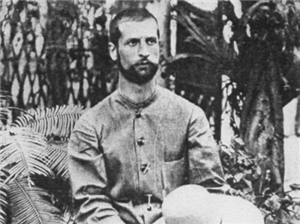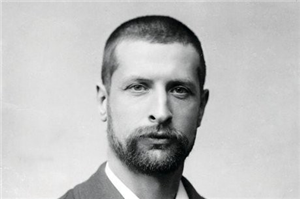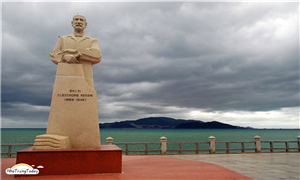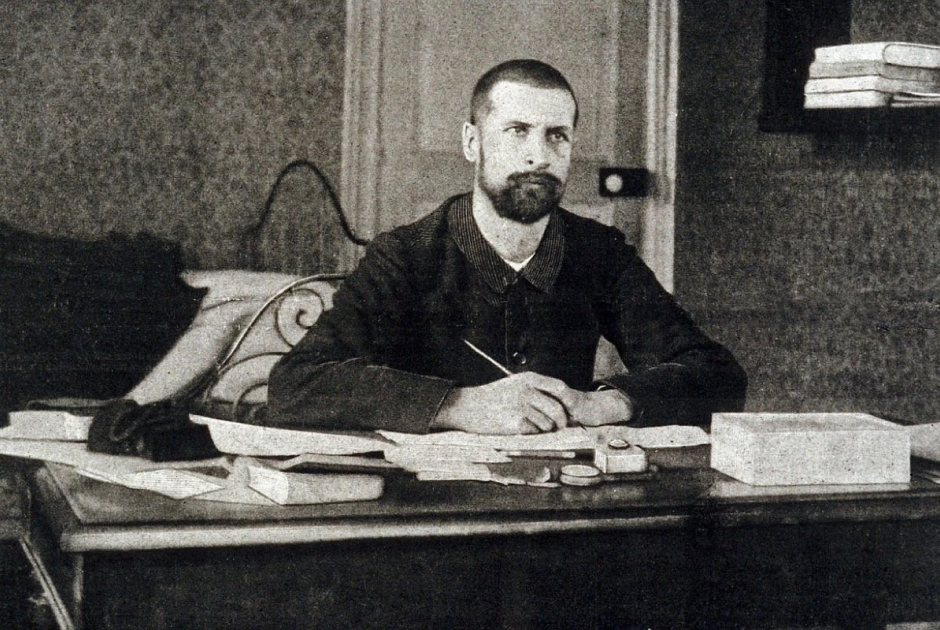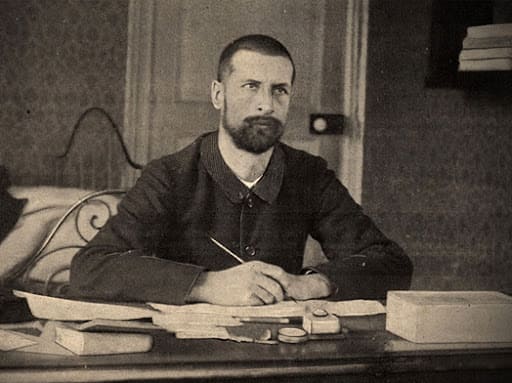Dr. Alexandre Yersin (1863 – 1943) – The Discoverer of Da Lat
After his travels in India, the French governor Paul Doumer desired to establish a resort for French expatriates similar to those in India. Yersin proposed that Dankia, located more than 10 km northwest of Da Lat, should be chosen.

Yersin’s Biography
On September 22, 1863, Alexandre Yersin was born in a mountainous region in Navanux, part of the Vaud district in Switzerland.
In 1865, King Louis XIV revoked the Edict of Nantes, which previously granted equal treatment to Calvinist Protestants. Yersin’s ancestors, facing persecution, left their homeland in the Languedoc region of France and migrated to Switzerland.
Yersin’s father was a biology teacher, and his mother hailed from Paris. Yersin was the youngest sibling in a family with two older sisters. He was modest and reserved, speaking little about his childhood, so few details are known about his early life.
At the age of 20 (1883), Yersin studied medicine in Lausanne, Switzerland. He then continued his studies in Marburg, Germany, and graduated from the University of Paris, France. From 1886, he worked at the Pasteur Institute in Paris, collaborating with Dr. Roux in the search for the toxin produced by the bacillus responsible for bubonic plague. In 1890, he became a French citizen.
During his years of intensive research at the Pasteur Institute in Paris, Yersin demonstrated exceptional talent and a relentless pursuit of knowledge. A bright future lay ahead of him. However, Yersin yearned for new horizons, seeking to escape his current life: “I always dreamed of exploring distant lands, of adventure. When young, we imagine that strange things will happen. Nothing seems impossible.”
Thus, Yersin unexpectedly abandoned bacteriology and embraced a life at sea and exploration, embarking on a new journey that would span 50 years.
Journey to Vietnam
Initially, Yersin accepted a position as a ship’s doctor for a maritime transportation company to the Far East. After six months operating on the Saigon – Manila route, Yersin transferred to the Saigon, which sailed between Saigon and Hai Phong.
The first few months in the maritime profession were truly captivating for Yersin! Though he had never been exposed to the open sea, during his youth, Yersin had become familiar with Lake Geneva. When the ship swayed on the ocean, Yersin looked up at the sky and learned to determine coordinates. Upon reaching land, Yersin studied astronomy.
While sailing the Hai Phong – Saigon route, as the ship approached the coast and sailed through the waves offshore, the majestic Truong Son Range in the west came into view, evoking memories of Yersin’s school days. On that day, Yersin had climbed the slopes of Valais. Though the Truong Son Range lacked the contours and colors of the Alps, it held its own mysterious allure. Yersin sought to rediscover the genuine and intimate feelings of exploring the unknown, setting foot on foreign soil.
In July 1891, Yersin arrived in Nha Trang. He disembarked, traversing the coastal region to Phan Rí and crossing a pass at 1,200 meters near Di Linh. From Di Linh, he planned to trek through the jungle to Saigon to find a land route connecting Nha Trang to Saigon. However, he missed the Hải Phòng-bound train and abandoned his journey, sailing from Phan Thiết to Nha Trang.
This brief initial exploration helped the 30-year-old explorer become acquainted with the challenges of tropical mountainous regions — the mountain winds, jungle rains, blood-sucking insects, and cascading streams — fostering a desire for further expeditions. Yersin’s first encounter with the Central Highlands’ forests also fueled his desire for future explorations.
On March 29, 1892, from Nha Trang to Ninh Hòa, he headed west toward Stung-treng on the Mekong River.
With the support of Pasteur and the French Minister of Education, in 1893, Yersin embarked on an expedition to the mountainous regions between the Central Coast and the Mekong River, including the upper reaches of the Dong Nai and Sebangcan rivers, areas seldom explored. Departing from Saigon, he passed Trị An Falls to Tánh Linh, crossed the La Ngà River to Di Linh, and followed a trail similar to the present-day National Highway 20. On June 21, 1893, he reached Prenn Falls and then ascended Lang Biang Mountain.
“On the way, the plateau rises from 900 meters to 1,200 meters over a distance of about 15 to 20 kilometers before reaching the mountain foot. I stood on a completely bare land with no trees or grass. The undulating terrain made me feel like I was sailing on a turbulent ocean with giant waves. Lang Biang Mountain stood prominently in the middle like an island, seeming to recede further as I approached. In the valleys, the soil was black and coal-filled. Herds of deer allowed us to approach a few hundred meters, then swiftly ran away, curiously looking back at us.”
At the end of 1893, Yersin returned to the Lang Biang Plateau, exploring the Dak Lak Highlands, A Tô Pơ (Laos), and returning to Đà Nẵng on May 7, 1894.
In 1890, Dr. Albert Calmette established a branch of the Pasteur Institute in Saigon. In 1894, a plague epidemic broke out across eastern China. Dr. Calmette suggested Yersin go to China to study the plague epidemic firsthand.
On June 15, 1894, Yersin arrived in Hong Kong and encountered a rival — Dr. Kitasato, who had arrived in Hong Kong three days earlier. This Japanese doctor was renowned for his scientific work in discovering the plague bacillus. Yersin erected a makeshift tent next to the hospital and worked under austere conditions. Just five days later, on June 20, 1894, he discovered the plague bacillus. Through the British postal system, he sent the plague bacillus samples to France. The plague bacillus reached the Pasteur Institute in Paris intact and was verified, bearing the name Yersinia pestis.
In 1895, Yersin established the Pasteur Institute in Nha Trang and produced serum to treat the plague. A year later, when the plague recurred in China, Yersin returned to China and saved many lives from the deadly epidemic that had killed 50 million people in ancient times.
Returning to Nha Trang, a new chapter in Yersin’s life began, posing many challenges. Recognizing that the city of Nha Trang was built on white sand and unsuitable for expanding pastures to raise horses for serum production, he explored the Suối Dầu area, 10 kilometers south of Nha Trang, where he established a livestock farm and agricultural cultivation.
Following the example of his predecessors, he delved into researching serum therapy for plague in cattle. Thus, the Pasteur Institute in Nha Trang studied animal and fish pathogens.
During a stopover in Malaysia and Indonesia, Yersin paid close attention to rubber cultivation. In 1897, he began planting rubber trees at Suối Dầu, and eight years later (1905), the Michelia Company (France) harvested the first 1,316 kilograms of rubber latex. Interested in the methods of planting, harvesting, and processing rubber, he established an agricultural laboratory. Here, systematic research on breeding, tapping, and coagulating rubber latex greatly benefited rubber growers in Indochina.
Over time, the livestock farm and agricultural cultivation at Suối Dầu expanded, and Yersin was appointed director of the Pasteur Institutes in Saigon and Nha Trang.
From 1902 to 1903, he went to Hanoi to establish the Yersin Indochina Medical School and served as its first principal.
In 1924, he held the position of Inspector General of the Pasteur Institutes in Indochina.
In 1933, he became the honorary director of the Pasteur Institute in Paris.
During his time in Cồn Hamlet (Nha Trang), he was a generous neighbor, often assisting the elderly and fishermen, and showing affection for children. He lived a simple life, rich in compassion.
After a trip to India, High Commissioner Paul Doumer wanted to build a resort for French expatriates similar to those in India. Yersin suggested choosing Đankia, located more than 10 kilometers northwest of Dalat.
In 1899, he accompanied Paul Doumer to Dalat. After on-site observations, Paul Doumer did not choose Đankia as the resort location but instead chose the current site of Dalat based on the recommendation of Dr. Emile Tardif because:
– Dalat is situated at a higher altitude than Đankia.
– The slopes of Dalat are gentle, and its air is more hygienic than that of Đankia. Dalat features small hills separated by marshy valleys.
– The atmosphere in Dalat is cooler and less humid than in Đankia because Đankia is near the Lang Biang summit, where moist winds blow, resulting in more rainfall and fog (fog only dissipates around 10 a.m.).
– Regarding vegetation, Đankia mainly consists of small hills, while Dalat is close to pine forests, offering a cool and fragrant pine scent.
– In terms of transportation, Dalat is more convenient than Đankia.
In 1914, World War I erupted. At that time, the Netherlands monopolized the production of quinine, the only drug to treat malaria. Yersin planted Canh Ki Na seeds at Suối Dầu and Đankia. He failed completely at Suối Dầu, but Đankia required even more effort.
In 1917, Yersin planted Canh Ki Na trees at Hòn Bà, a mountain near Suối Dầu. Initially, the trees grew well but later died due to unsuitable soil.
In July 1923, the best Canh Ki Na trees at Hòn Bà were brought to Đran for planting, yielding good results. He continued planting them on the small Lang Biang plateau and in Di Linh.
In 1936, Canh Ki Na trees were planted on a large scale in Lán Tranh and Di Linh, yielding 30 tons of bark with a Quinine Sulfate content of 7.42%.
In 1938, 21 tons of bark were harvested with a higher Quinine Sulfate content (8.5%).
On June 28, 1935, the Yersin High School was inaugurated in Dalat. Yersin returned to Dalat for the last time before his death. On this occasion, in response to a student’s speech, he expressed his feelings upon setting foot on the Lang Biang plateau: “The cool air made me forget my fatigue, and I recalled the joy of running up and down the hills like a young high school student.”
In his final years, Yersin remained passionate about scientific research, particularly in Astronomy and Radio Engineering. Despite his illness, he continued to monitor tidal levels.
On March 1, 1943, Yersin passed away peacefully at the age of 80, leaving behind deep sorrow. Thousands of people from Nha Trang escorted his remains to their final resting place at Suối Dầu.
Upon arriving in Vietnam in the late 19th and early 20th centuries, Yersin worked within the colonial apparatus of French rule. However, his diverse scientific contributions, simple life, compassion, and love for Vietnam remain etched in the hearts and minds of the people of Dalat, Nha Trang, and our planet. The capital Hanoi, Ho Chi Minh City, and Nha Trang have named streets after Yersin. In Dalat, the road leading to the former Yersin High School (now the Pedagogical College) is named after the French scientist who carried the weight of Vietnamese sentiment and left unforgettable memories in Dalat: Alexandre Yersin.
Three memorials dedicated to Dr. Alexandre Yersin:
– The Yersin Library at the Pasteur Institute in Nha Trang, Khanh Hoa Province.
– Linh Son Pagoda, located in Suoi Cat Commune, Dien Khanh District, Khanh Hoa Province (the former workplace of Dr. Yersin at Suoi Dau).
– The tomb of Dr. Yersin, located in Suoi Cat Commune, Dien Khanh District, Khanh Hoa Province.
In 1891, he arrived in Nha Trang to establish the first bacteriological research facility in Vietnam. By the beginning of 1899, this location had become the Pasteur Institute in Nha Trang.
After over 50 years of living and working for science at the Pasteur Institute in Nha Trang (1891 – 1943), Yersin contributed 55 valuable research works to the field of science.
Positions held by Yersin:
– Director of the Pasteur Institute in Nha Trang.
– Director of the Pasteur Institute in Indochina.
– Dean of the Medical University of Hanoi.
– Inspector General of the Pasteur Institutes in Indochina.
– Member of the French Academy of Sciences.
– Honorary Chairman of the Medical Council of the Pasteur Institute in Paris.

